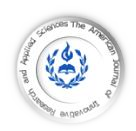
GENERAL INFORMATION
| HOME | ABOUT US | ARCHIVE | AIMS AND SCOP | AUTHORS | REVIEW | SUMIBMIT MANUSCRIPT | EDITORIAL BOARED | PUBLICATION FEE |

| HOME || ABOUT US || ARCHIVES || AIMS AND SCOP || AUTHORS || REVIEW|| SUBMIT MANUSCRIPT || EDITORIAL BOARD |

| Info-AJIRAS-® Journal ISSN 2429-5396 (Online) / Reference CIF/15/0289M |
American Journal of Innovative Research & Applied Sciences

|
American Journal of innovative
Research & Applied Sciences
Research & Applied Sciences
ISSN 2429-5396 (Online)
OCLC Number: 920041286
OCLC Number: 920041286

Authors Contact
*Correspondant author and authors Copyright © 2022:
| Hobinirina Andrianantenaina 1,2* | Anthonio Randriatsimihory 2 | Fabbie Razafindrabe 2 | Edmond Randrianarivony 1| et | A.J. Franck Ratovonjanahary 1 |
Affiliation.
1. Parcours de Physique Nucléaire Appliquée et Environnement | Université d’Antananarivo | Madagascar|
2. ONG, GRET | Madagascar |
This article is made freely available as part of this journal's Open Access: ID | Coulibaly-Ref6-6-15ajiras251022 |
*Correspondant author and authors Copyright © 2022:
| Hobinirina Andrianantenaina 1,2* | Anthonio Randriatsimihory 2 | Fabbie Razafindrabe 2 | Edmond Randrianarivony 1| et | A.J. Franck Ratovonjanahary 1 |
Affiliation.
1. Parcours de Physique Nucléaire Appliquée et Environnement | Université d’Antananarivo | Madagascar|
2. ONG, GRET | Madagascar |
This article is made freely available as part of this journal's Open Access: ID | Coulibaly-Ref6-6-15ajiras251022 |



RESUME
Introduction : Le co-compostage de déchets organiques avec des excréments humains est l'une des techniques de réutilisation dans le secteur des déchets solides. Le co-compostage permet de valoriser le produit dans ses deux composantes. Objectif : Cette étude vise à analyser qualitativement et quantitativement le co-compost en métaux lourds et éléments minéraux tels que le fer, le titane, le manganèse, le zinc, le strontium, le cuivre, le plomb, le cobalt, le rubidium. Méthodes : Une étude comparative avec la norme actuelle a également été réalisée. La méthode utilisée pour la détection est la fluorescence aux rayons X et pour les échantillons, huit (08) types différents de co-compost ont été réalisés afin d'obtenir une conclusion optimale sur la composition du co-compost. Résultats : Les résultats montrent que tous les co-compost contiennent du fer dont le pourcentage varie entre 2,7% et 4,2%. La concentration de plomb dans les échantillons varie de 45,4 mg/kg à 70,4 mg/kg. On note également la présence de titane, strontium, rubidium, cobalt, manganèse, zinc, cuivre. Conclusion : La concentration en métaux lourds et autres éléments ne dépend pas directement de la proportion de digestat par rapport à la matière organique. Toutes les concentrations sont conformes à la norme..
Mots clés : Analyse XRF, métaux lourds, co-compost, déchets solides, déchets liquides.
ABSTRACT
Introduction: The co-composting of organic waste with human excrement is one of the reuse techniques in the solid waste sector. The co-composting allows to valorize the product in its two components. Objective: This study aims to analyze qualitatively and quantitatively the co-compost in heavy metals and mineral elements such as iron, titanium, manganese, zinc, strontium, copper, lead, cobalt, rubidium. Methods: A comparative study with the current standard was also carried out. The method used for detection is X-ray fluorescence and for the samples, eight (08) different types of co-compost were made in order to obtain an optimal conclusion on the composition of co-compost. Results: The results show that all the co-compost contain iron whose percentage varies between 2.7% and 4.2%. The concentration of lead in the samples varied from 45.4 mg/kg to 70.4 mg/kg. The presence of titanium, strontium, rubidium, cobalt, manganese, zinc and copper was also noted. Conclusion: The concentration of heavy metals and other elements does not depend directly on the proportion of digestate to organic matter. All concentrations are in accordance with the standard.
Keywords: XRF analysis, heavy metals, co-compost, solid waste, liquid waste.
Introduction : Le co-compostage de déchets organiques avec des excréments humains est l'une des techniques de réutilisation dans le secteur des déchets solides. Le co-compostage permet de valoriser le produit dans ses deux composantes. Objectif : Cette étude vise à analyser qualitativement et quantitativement le co-compost en métaux lourds et éléments minéraux tels que le fer, le titane, le manganèse, le zinc, le strontium, le cuivre, le plomb, le cobalt, le rubidium. Méthodes : Une étude comparative avec la norme actuelle a également été réalisée. La méthode utilisée pour la détection est la fluorescence aux rayons X et pour les échantillons, huit (08) types différents de co-compost ont été réalisés afin d'obtenir une conclusion optimale sur la composition du co-compost. Résultats : Les résultats montrent que tous les co-compost contiennent du fer dont le pourcentage varie entre 2,7% et 4,2%. La concentration de plomb dans les échantillons varie de 45,4 mg/kg à 70,4 mg/kg. On note également la présence de titane, strontium, rubidium, cobalt, manganèse, zinc, cuivre. Conclusion : La concentration en métaux lourds et autres éléments ne dépend pas directement de la proportion de digestat par rapport à la matière organique. Toutes les concentrations sont conformes à la norme..
Mots clés : Analyse XRF, métaux lourds, co-compost, déchets solides, déchets liquides.
ABSTRACT
Introduction: The co-composting of organic waste with human excrement is one of the reuse techniques in the solid waste sector. The co-composting allows to valorize the product in its two components. Objective: This study aims to analyze qualitatively and quantitatively the co-compost in heavy metals and mineral elements such as iron, titanium, manganese, zinc, strontium, copper, lead, cobalt, rubidium. Methods: A comparative study with the current standard was also carried out. The method used for detection is X-ray fluorescence and for the samples, eight (08) different types of co-compost were made in order to obtain an optimal conclusion on the composition of co-compost. Results: The results show that all the co-compost contain iron whose percentage varies between 2.7% and 4.2%. The concentration of lead in the samples varied from 45.4 mg/kg to 70.4 mg/kg. The presence of titanium, strontium, rubidium, cobalt, manganese, zinc and copper was also noted. Conclusion: The concentration of heavy metals and other elements does not depend directly on the proportion of digestate to organic matter. All concentrations are in accordance with the standard.
Keywords: XRF analysis, heavy metals, co-compost, solid waste, liquid waste.

| ISSN: 2429-5396 (e) | https://www.american-jiras.com | |
| Web Site Form: v 0.1.05 | JF 22 Cours, Wellington le Clairval, Lillebonne | France |
| Web Site Form: v 0.1.05 | JF 22 Cours, Wellington le Clairval, Lillebonne | France |
| DECEMBER | VOLUME 15 | ISSUE N° 6 | 2022 |
| ARTICLES | Am. J. innov. res. appl. sci. Volume 15, Issue - 6 Pages 232-239 (Decmber 2022)
ANALYSE DES METAUX LOURDS ET ELEMENTS MINERAUX DANS LES CO-COMPOSTS PAR UTILISATION DE SPECTROMETRIE DE FLUORESCENCE
ANALYSIS OF HEAVY METALS AND MINERAL ELEMENTS IN CO - COMPOSTS BY USING FLUORESCENCE SPECTROMETRY
| Hobinirina Andrianantenaina 1,2* | Anthonio Randriatsimihory 2 | Fabbie Razafindrabe 2 | Edmond Randrianarivony 1| et | A.J. Franck Ratovonjanahary 1 |. Am. J. innov. res. appl. sci. 2022; 15(6):232-239.
| PDF FULL TEXT | | XML FILE|
ANALYSIS OF HEAVY METALS AND MINERAL ELEMENTS IN CO - COMPOSTS BY USING FLUORESCENCE SPECTROMETRY
| Hobinirina Andrianantenaina 1,2* | Anthonio Randriatsimihory 2 | Fabbie Razafindrabe 2 | Edmond Randrianarivony 1| et | A.J. Franck Ratovonjanahary 1 |. Am. J. innov. res. appl. sci. 2022; 15(6):232-239.
| PDF FULL TEXT | | XML FILE|